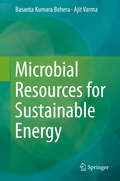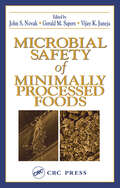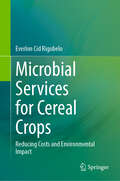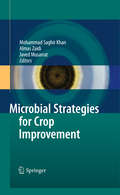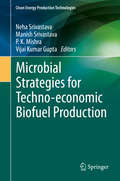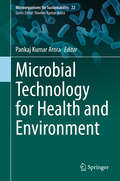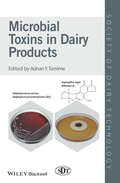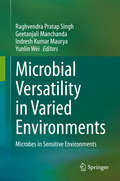- Table View
- List View
Microbial Products for Health and Nutrition
by Prasun Kumar Vijay Kothari Subhasree RayThis book highlights microbial products and their applications in the health sector. The chapters introduce novel advancements and applications in different pharmaceutical and nutraceutical aspects of applied microbiology. Readers will obtain a detailed overview of the relevance of microbial metabolites to human health and nutrition. Besides knowing the products already developed, they will also get an idea of microbial products currently in the development pipeline and those that are likely to emerge as potential nutraceuticals. Readers will get an interesting and useful perspective on how supplementing food with microbes or their bioactive metabolites can realize the idea of 'food as medicine'. This book introduces the biological activities of various microbial fermentation products, and how they are relevant to mitigating various disease conditions (e.g. neuropathy, diabetes, gut dysbiosis, malnutrition, etc.) in humans. One of the highlights of this volume is the exploration of microbial pigments as potential substitutes for synthetic colorants, offering safer and more sustainable alternatives for the food and healthcare industries. The book has equivalent contributions from experts in academia and industry to fill the communication gap between them. Through this book, readers will gain valuable insights into the historical perspectives, contemporary impacts, and future prospects of microbial applications in health and nutrition. From food preservation to biopharmaceutical production, the potential of microbial products to revolutionize our approach to health and wellness is undeniable.
Microbial Products: Applications and Translational Trends (Microbial Biotechnology for Food, Health, and the Environment)
by Mamtesh Singh Gajendra Pratap Singh Shivani TyagiMicrobial Products: Applications and Translational Trends offers complete coverage of the production of microbial products, including biopolymers, biofuels, bioactive compounds, and their applications in fields such as bioremediation, agriculture, medicine, and other industrial settings. This book focuses on multiple processes including upstream procedures and downstream processing, and the tools required for their production. Lab-scale development processes may not be as efficient when aiming for large-scale industrial production, so it is necessary to utilize in silico modeling tools for bioprocess design to ensure success at translational levels. Therefore, this book presents in silico and mathematical simulations and approaches used for such applications. Further, it examines microbial products produced from bacteria, fungi, and algae. These major microbial categories have the capacity to produce various, diverse secondary metabolites, bioactive compounds, enzymes, biopolymers, biofuels, probiotics, and more. The bioproducts examined in the book are of great social, medical, and agricultural benefit, and include examples of biodegradable polymers, biofuels, biofertilizers, and drug delivery agents. Presents approaches and tools that aid in the design of eco-friendly, efficient, and economic bioprocesses. Utilizes in silico and mathematical simulations for optimal bioprocess design. Examines approaches to be used for bioproducts from the lab scale to widely applied microbial biotechnologies. Presents the latest trends and technologies in the production approaches for microbial bio-products manufacture and application. This book is ideal for both researchers and academics, as it provides up-to-date knowledge of applied microbial biotechnology approaches for bio-products.
Microbial Quality of Water Supply in Distribution Systems
by Edwin E. GeldreichHidden problems, buried deep in the pipe networks of water distribution systems, are very serious potential threats to water quality. Microbial Quality of Water Supply in Distribution Systems outlines the processes and issues related to the degradation of water quality upon passage through networks of pipes, storage reservoirs, and standpipes on its way to the consumer. The risks associated with biofilm accumulation, bacteria, and other contaminants are discussed in great detail. In addition to its excellent microbiological coverage of organisms in drinking water and biofilms in distribution systems, Microbial Quality of Water Supply in Distribution Systems provides clear treatments of the technical and public communication issues most commonly affecting the quality of water and water supply systems. The inclusion of numerous case histories in this new book makes it a complete reference source for anyone concerned with water quality and water distribution systems.
Microbial Rejuvenation of Polluted Environment: Volume 1 (Microorganisms for Sustainability #25)
by Deepak G. Panpatte Yogeshvari K. JhalaPollution is one of the most serious issues facing mankind and other life forms on earth. Environmental pollution leads to the degradation of ecosystems, loss of services, economic losses, and various other problems. The eco-friendliest approach to rejuvenating polluted ecosystems is with the help of microorganism-based bioremediation. Microorganisms are characterized by great biodiversity, genetic and metabolic machinery, and by their ability to survive, even in extremely polluted environments. As such, they are and will remain the most important tools for restoring polluted ecosystems / habitats. This three-volume book sheds light on the utilization of microorganisms and the latest technologies for cleaning up polluted sites. It also discusses the remediation or degradation of various important pollutants such as pesticides, wastewater, plastics, PAHs, oil spills etc. The book also explains the latest technologies used for the degradation of pollutants in several niche ecosystems. Given its scope, the book will be of interest to teachers, researchers, bioremediation scientists, capacity builders and policymakers. It also offers valuable additional reading material for undergraduate and graduate students of microbiology, ecology, soil science, and the environmental sciences.
Microbial Rejuvenation of Polluted Environment: Volume 2 (Microorganisms for Sustainability #26)
by Deepak G. Panpatte Yogeshvari K. JhalaPollution is one of the most serious issues facing mankind and other life forms on earth. Environmental pollution leads to the degradation of ecosystems, loss of services, economic losses, and various other problems. The eco-friendliest approach to rejuvenating polluted ecosystems is with the help of microorganism-based bioremediation. Microorganisms are characterized by great biodiversity, genetic and metabolic machinery, and by their ability to survive, even in extremely polluted environments. As such, they are and will remain the most important tools for restoring polluted ecosystems / habitats. This three-volume book sheds light on the utilization of microorganisms and the latest technologies for cleaning up polluted sites. It also discusses the remediation or degradation of various important pollutants such as pesticides, wastewater, plastics, PAHs, oil spills etc. The book also explains the latest technologies used for the degradation of pollutants in several niche ecosystems. Given its scope, the book will be of interest to teachers, researchers, bioremediation scientists, capacity builders and policymakers. It also offers valuable additional reading material for undergraduate and graduate students of microbiology, ecology, soil science, and the environmental sciences.
Microbial Remediation of Azo Dyes with Prokaryotes
by Maulin P ShahThis book details microbial remediation of azo dyes from wastewater including information on existing methods and technologies, their graduation, the emergence of new technologies, industrial practices, and real-case studies. Emphasis is placed on industrial applications and the elimination of toxic pollutants from wastewater through bacterial approach. Specific aspects discussed include effective separation through new adsorbents / newcomers, ion exchange process, coagulation / formulations, separations, and biological methods from wastewater. This book explains a paradigm shift towards the recovery of materials and energy from azo dye containing wastewater. Features: Provides information on the topic of prokaryotic-based technologies for azo dye degradation in wastewater treatment plant. Describes microbial enzymes and their role in bioremediation of environmental pollutants. Covers industrial acid mine tailing wastes, plastic wastes, distillery, and pulp paper industry effluent. Discusses critical insight into limitations of related technologies. Explains concepts through illustrations, figures, tables, and trivia boxes. This book aims at Researchers, Professionals, Graduate Students in Bioremediation and Environmental Protection, Waste Management, Applied Microbiology, Botany and Plant Biotechnology.
Microbial Remediation of Hazardous Chemicals from Water & Industrial Wastewater Treatment Plant (Environmental Science and Engineering)
by Maulin P. ShahThis book discusses the new and emerging innovative trends in the bioremediation of hazardous pollutants found in wastewater. It also includes the fate of pollutants produced after the treatment process both at the laboratory scale and at the industrial scale. The book intrusively explores the unique biological aspects of the wastewater treatment process and highlights the advantages they provide for engineering applications in the industries. Each chapter covers a different biological-based approach and examines the basic principles, practical applications, recent breakthroughs, and associated limitations. It presents an array of cutting-edge wastewater treatment research and thereafter its applications in treatment, remediation, sensing, and pollution prevention processes. The biological process for application in wastewater research has a significant impact on maintaining the long-term quality, availability, and viability of water. This book elucidates the technologies of biological wastewater treatment processes. The biological processes presented in wastewater treatment processes include (1) bioremediation of wastewater that includes aerobic treatment (oxidation ponds, aeration lagoons, aerobic bioreactors, activated sludge, percolating or trickling filters, biological filters, rotating biological contactors, biological removal of nutrients) and anaerobic treatment (anaerobic bioreactors, anaerobic lagoons); (2) phytoremediation of wastewater that includes constructed wetlands, rhizofiltration, rhizodegradation, phytodegradation, phytoaccumulation, phytotransformation, and hyperaccumulators; and (3) mycoremediation of wastewater. The book describes a broad area of biological processes and water research which are considered key components for advanced water purification. It also includes the desalination technologies that remove, reduce, or neutralize water contaminants that threaten human health and/or ecosystem productivity and integrity.
Microbial Resources for Sustainable Energy
by Ajit Varma Basanta Kumara BeheraThis book sheds new light on how microbes can be used as effective and sustainable resources to produce green energy in the form of biogas, algal diesel, ethanol, hydrogen and direct electricity. It discusses topics such as microbial energy conversion technologies, including ethanol production by microbial catalytic reaction, biomethanization, biodiesel from microalgae, microbial fuel cells, and the microbiological production of hydrogen. The book will inspire scientists to find new approaches to meet local energy demands with the help of sustainable microbial resources available in and around a given location.
Microbial Safety of Fresh Produce
by Xuetong Fan Christopher J. Doona Robert B. Gravani Florence E. Feeherry Brendan A. NiemiraMicrobial Safety of Fresh Produce covers all aspects of produce safety including pathogen ecology, agro-management, pre-harvest and post-harvest interventions, and adverse economic impacts of outbreaks. This most recent edition to the IFT Press book series examines the current state of the problems associated with fresh produce by reviewing the recent, high-profile outbreaks associated with fresh-produce, including the possible internalization of pathogens by plant tissues, and understanding how human pathogens survive and multiply in water, soils, and fresh fruits and vegetables.
Microbial Safety of Minimally Processed Foods
by Vijay K. Juneja John S. Novak Gerald M. SapersWhile minimally processed foods satisfy the increasing market demands for foods with fewer preservatives, higher nutritive value, and fresh sensory attributes, there is a greater risk of diseases if they are improperly handled. Microbial Safety of Minimally Processed Foods explores innovative preventative solutions to food-borne diseases from the p
Microbial Services for Cereal Crops: Reducing Costs and Environmental Impact
by Everlon Cid RigobeloThis book will focus on microbial services as an excellent strategy to face the current challenge of global agriculture, collecting the principal studies that used microbial services for improving cereal production, such as rice, beans, maize and wheat. This book will address studies and discussion about the bacterial world inside the plant; phytostimulator microorganisms; promotion of maize growth for biocontrol; filamentous fungi as plant growth promoters; mycorrhiza; sustainable agriculture effects on the microbiome; humic substances in combination with plant growth-promoting bacteria in rice; and the changes in plant metabolome induced by microorganisms under environmental stress.
Microbial Strategies for Crop Improvement
by Javed Musarrat Almas Zaidi Mohammad Saghir KhanThis book presents the multidisciplinary nature and the many fascinating aspects of microbiological approaches for crop improvement in both conventional and stressed soils where quality and safety are the key concerns. The major goal is to provide a cross-section of the latest accomplishments and envisaged future directions in these areas. It gives a holistic view of the basic concepts and practical utility of microbes and thus presents an all-inclusive contemporary treatise on strategic aspects of the diverse microbial communities providing solutions to oodles of customary agronomic problems. This book benefits people working in the area of agronomy, biotechnology, environmental biology, microbiology, plant physiology, plant protection and soil science. The contributions by eminent academicians and professionals ensure a good equilibrium between theory and practice without compromising the basic conceptual framework of the concerned subject.
Microbial Strategies for Techno-economic Biofuel Production (Clean Energy Production Technologies)
by P. K. Mishra Vijai Kumar Gupta Neha Srivastava Manish SrivastavaBiofuels are one of the most sustainable options when it comes to renewable energy sources to replace fossil fuels. Biotechnological processes, such as microbial fermentation, are used to produce energy from waste biomass by converting organic substrates into biofuels. This book discusses practices to improve and enrich various microbial communities in order to enhance sustainable and economical biofuel production. It also evaluates various strategies to develop potential microorganisms and microbial consortia to produce highly efficient biofuels at a relatively low cost.
Microbial Stress Adaptation and Food Safety
by Vijay K. Juneja Ahmed E. YousefThe first book to address the subject, Microbial Stress Adaptation and Food Safety emphasizes the implications of stress adaptation and its consequences for food safety. It covers the basic science, kinetics, mechanisms, assessment, and control of stress adaptation and its impact on the safety of foods produced by minimal processing or non-thermal technologies. World renowned experts in the field provide detailed accounts of problems associated with stress adaptation and suggest practical solutions for overcoming these problems.
Microbial Surfactants: Volume 2: Applications in Food and Agriculture (Industrial Biotechnology)
by R. Z. SayyedBiosurfactants are surface-active biomolecules produced by a wide variety of microorganisms. They can be produced from renewable sources, and possess high surface activity, high specificity, low toxicity, tolerance to pH, temperature and ionic strength, biodegradability, excellent emulsifying and demulsifying ability and antimicrobial activity. Biosurfactants have found applications in several industries including organic chemicals, petrochemicals, mining, metallurgy (mainly bioleaching), agrochemicals, fertilizers, foods, beverages, cosmetics, pharmaceuticals and many others. The main aim of this volume is to highlight concepts, classifications, production and applications of microbial surfactants in food and agriculture. The book provides a comprehensive coverage of fermentation, recovery, genomics and metagenomics of biosurfactant production. It is presented in an easy-to-understand manner, and includes protocols, figures, and recent data on the industrial demand market and economics, and the production of biosurfactants from novel substrates are particularly worthwhile additions. The volume will be useful for students, researchers, teachers, and entrepreneurs in the area of microbial biosurfactants and their applications in food and agriculture.
Microbial Symbionts and Plant Health: Trends and Applications for Changing Climate (Rhizosphere Biology)
by Swarnendu Roy Piyush Mathur Rupam KapoorThis book provides a comprehensive understanding of the complex relationship between microbial symbionts and plants in the era of climate change. It focuses on the plant microbiome associated with different plant organs like roots, leaves, stems, fruit, and seeds, and showcases their significant role in the enhancement of crop yield and protection in a sustainable manner. Concomitantly, acumens to the most emerging trends in plant microbial research that includes rhizosphere engineering and metagenomics are also covered in this title. The association of microbial symbionts with the host offers a wide advantage in terms of acclimatization to varied environmental conditions. A large number of microbes such as cyanobacteria, PGPR, endophytes, and AMF have been shown to improve plant growth and production under the effect of various abiotic and biotic stresses. These microbial symbionts secrete several secondary metabolites, signaling molecules, and hydrolytic enzymes that play a multifarious role in improving plant growth and yield. Moreover, the symbionts have been known to regulate the host responses at the molecular level. Bioprospecting these microbial symbionts will provide an alternative to the chemical-based fertilizers and pave the path for the development of biofertilizers. The book is a suitable reading material for undergraduate and postgraduate students, researchers, and scientists working in the field of agricultural biotechnology, microbiology, mycology and plant pathology, and allied fields of plant and microbial sciences. The book in this context attempts to provide an integrative and exhaustive study as well as research material that would help the scientific community in wide respect.
Microbial Synthesis of Chalcogenide Nanoparticles: Combining Bioremediation and Biorecovery of Chalcogen in the Form of Chalcogenide Nanoparticles (IHE Delft PhD Thesis Series)
by Joyabrata MalRecent years have seen a growing interest in the application of chalcogenide nanoparticles (NPs), e.g. Se, Te, CdSe and CdTe NPs, in various industrial sectors including energy, petroleum refining and in the field of biology and medicine. Moreover, due to the high toxicity of chalcogen oxyanions, their release into the environment is of great concern. Thus, emphasis was given in this study on the development of a novel microbial synthesis process of chalcogenide NPs by combining biological treatment of Se/Te containing wastewaters with biorecovery in the form of Se NPs, Te NPs and CdSe NPs. Enrichment of Se-oxyanion reducing microorganisms was carried out to simultaneously remove selenite (Se(IV)) and cadmium (Cd(II)) from wastewaters by combining bioremediation of toxic Se-rich wastewater with the biorecovery of Se as CdSe NPs. The results showed compositional changes in the extracellular polymeric substances (EPS) matrix of the anaerobic granular sludge upon exposure to Cd(II) and Se(IV) and identified the roles of EPS fractions in the biogenesis of CdSe NPs. Besides, it was found that the EPS on the surface of the biogenic Se NPs play a major role in lowering the bioavailability and toxicity of biogenic Se(0) compared to chemogenic Se(0) NPs. An upflow anaerobic sludge blanket (UASB) reactor was used for the first time to continuously remove tellurite from wastewater and recover biogenic Te(0).
Microbial Technology for Health and Environment (Microorganisms for Sustainability #22)
by Pankaj Kumar AroraRampant industrialization has caused high levels of contamination by various toxic chemicals in our water bodies, which is a matter of concern in terms of ecosystems, as well as human and animal health. Polluted wastewater can contaminate drinking water and is also is a causal factor for bio-magnification of heavy metals into our food cycle. In the last decade, several methodologies have been adopted to clean the wastewaters, and among these, microbial remediation has emerged as an effective technology. Several variants of microbial technologies have been developed for wastewater treatment and biodegradation specific to the industry, type of waste and toxicity of the chemicals.This book describes the recent advances in microbial degradation and microbial remediation of various xenobiotic compounds in soil and wastewater. It also explains various modern microbial technologies for biodegradation and wastewater treatment. It covers various microbial technologies for wastewater treatment, biodegradation, bioremediation and solid waste management. Gathering contributions from leading international it focuses on the status quo in industrial wastewater treatment and its biodegradation.The book is intended for researchers in the field of industrial wastewater, students of environmental sciences and practitioners in water pollution abatement.
Microbial Technology for Sustainable E-waste Management
by Ravindra Soni Deep Chandra Suyal Saurabh Kumar Prasenjit DebbarmaThis book, besides discussing challenges and opportunities, will reveal the microbe-metal interactions and strategies for e-waste remediation in different ecosystems. It will unveil the recent biotechnological advancement and microbiological approach to sustainable biorecycling of e-waste such as bioleaching for heavy metal extraction, valorization of precious metal, biodegradation of e-plastic, the role of the diverse microbial community in e-waste remediation, genetically engineered microbes for e-waste management, the importance of microbial exopolysaccharides in metal biosorption, next-generation technologies, omics-based technologies etc. It also holds the promise to discuss the conservation, utilization and cataloging indigenous microbes in e-waste-polluted niches and promising hybrid technology for sustainable e-waste management.Revolution in the area of information technology and communication is constantly evolving due to scientific research and development. Concurrently, the production of new electrical and electronic equipment also thus uplifting in this era of revolution. These technological advancements certainly have problematic consequences which is the rise of huge amounts of electronic obsoletes or electronic waste (e-waste). Improper management of both hazardous and nonhazardous substances of e-waste led to a major concern in our digital society and environment. Therefore, a sustainable approach including microbial candidates to tackle e-waste is the need of the hour.Nevertheless, the continuous demand for new-generation gadgets and electronics set this high-tech evolution to a new frontier in the last few years. With this continuing trend of technological development, e-waste is expanding exponentially worldwide. In the year of 2019, the worldwide generation of e-waste was approximately 53.6 Mt, of which only about 17.4% of e-waste was collected and recycled, and the other 82.6% was not even documented. E-waste contains various heterogeneous waste complexes such as metals (60%), blends of many polymers (30%) and halogenated compounds, radioactive elements and other pollutants (10%), respectively. The sustainable, efficient, and economic management of e-waste is thus, a challenging task today and in the coming decades. Conventional techniques such as the use of chemicals, incineration and informal ways of e-waste dismantling trigger serious health risks and contamination to the human population and environment, respectively due to the liberation of toxic and hazardous substances from the waste. In this context, bio-candidates especially microorganisms could be sharp-edged biological recycling tools to manage e-waste sustainably. As microbes are omnipresent and diverse in their physiology and functional aspects, they offer a wide range of bioremediation.
Microbial Technology for Sustainable Environment
by Pankaj Bhatt Saurabh Gangola Dhanushka Udayanga Govind KumarMicroorganisms are ubiquitous on earth. These microorganisms are able to perform various functions in the environment. Microbial applications are used as biofertilizers, bioremediation, biofortification and other sustainable approaches of environmental development. Indigenous microbial cultures have the potential to perform various functions that are beneficial to achieve the sustainable goals. To date, different strains have been commercialized for the industrial and common applications for the sustainable environment. This book will cover different aspects of microbial technology for sustainable development.
Microbial Toxins and Related Contamination in the Food Industry
by Giorgia Caruso Salvatore Parisi Caterina Barone Pasqualina Laganà Gabriella Caruso Lucia Melcarne Francesco Mazzù Antonino Santi DeliaThis Brief concerns the chemical risk in food products from the viewpoint of microbiology. The "Hazard Analysis and Critical Control Point" (HACCP) approach, which is applied for this purpose, is dedicated to the study and the analysis of all possible dangers by food consumptions and the related countermeasures with the aim of protecting the health of consumers. This difficult objective is highly multidisciplinary and requires a plethora of different competencies. This book thus addresses chemists, microbiologists, food technologists, medical professionals and veterinarians. The chemical risks described in this book are related to food additives, contaminants by food packaging materials, chemicals from cleaning systems and microbial toxins. The present book gives an introduction and overview of these various topics.
Microbial Toxins in Dairy Products
by Adnan Y. TamimeFood-borne diseases, including those via dairy products, have been recognised as major threats to human health. The causes associated with dairy food-borne disease are the use of raw milk in the manufacture of dairy products, faulty processing conditions during the heat treatment of milk, post-processing contamination, failure in due diligence and an unhygienic water supply. Dairy food-borne diseases affecting human health are associated with certain strains of bacteria belonging to the genera of Clostridium, Bacillus, Escherichia, Staphylococcus and Listeria, which are capable of producing toxins, plus moulds that can produce mycotoxins such as aflatoxins, sterigmatocytin and ochratoxin. Microbial Toxins in Dairy Products reviews the latest scientific knowledge and developments for detecting and studying the presence of these toxins in dairy products, updating the analytical techniques required to examine bacterial and mould toxins and the potential for contamination of milk as it passes along the food chain, i.e. from 'farm-to-fork'. This comprehensive and accessible collection of techniques will help dairy processors, food scientists, technologists, researchers and students to further minimise the incidences of dairy food-borne illnesses in humans.
Microbial Toxins in Food Systems: Causes, Mechanisms, Complications, and Metabolism
by Abdel Moneim Elhadi Sulieman Nawaf Ibrahim AlshammariWhen our food items become contaminated with pathogenic microorganisms, these microorganisms secrete microbial toxins which promote infection by attacking the host tissue’s immune system, thereby leading to foodborne intoxication, or poisoning, in consumers. Because these toxic microorganisms are not typically identifiable by taste, smell or sight, it is crucial to the safety of our food systems that they be detected through microbial testing. As the title suggests, Microbial Toxins: Causes, Mechanisms, Complications and Metabolism is a comprehensive overview of the life of these toxins from their pathogenesis through to their implications for human and environmental health. Including examples of salmonella, botulism, listeria and more, as well as various mycotoxins, this text will appeal to both microbiology researchers as well as food industry professionals. Beyond foodborne illness, this text also unpacks environmental toxicology and the role of microbial toxins in the development of novel anti-cancer drugs. Emerging techniques in the detection of microbial toxins will be discussed, setting this text apart from existing books on the subject. The use of proteomics in toxin identification, for example, allows for the determination of metabolic pathways and biomarkers of pathogenicity and resistance of biotoxins. This text furthers the study of foodborne hazards and has important implications for the improvement of safety in the food industry.
Microbial Versatility in Varied Environments: Microbes in Sensitive Environments
by Raghvendra Pratap Singh Geetanjali Manchanda Indresh Kumar Maurya Yunlin WeiThe book compiles the latest studies on microorganisms thriving in extreme conditions. Microbes have been found in extremely high and low temperatures, highly acidic to saline conditions, from deserts to the Dead sea, from hot-springs to underwater hydrothermal vents- the diversity is incredible. The various chapters highlight the microbial life and describe the mechanisms of tolerance to these harsh conditions, and show how an understanding of these phenomena can help us exploit the microbes in biotechnology. The theme of the book is highly significant since life in these environments can give vital clues about the origin and evolution of life on earth, as a lot of these conditions simulate the environment present billions of years ago. Additionally, the study of adaptation and survival of organisms in such environments can be important for finding life on other planets. This book shall be useful for students, researchers and course instructors interested in evolution, microbial adaptations and ecology in varied environments.
Microbial and Biotechnological Interventions in Bioremediation and Phytoremediation
by Junaid Ahmad MalikThe introduction of contaminants, due to rapid urbanisation and anthropogenic activities, into the environment causes unsteadiness, distress to the physico-chemical systems including living organisms, which possibly is threatening the dynamics of nature as well as the soil biology by producing certain xenobiotics. Hence, there is an immediate global demand for the diminution of such contaminants and xenobiotics which can otherwise adversely affect the living organisms. Some toxic xenobiotics include synthetic organochlorides such as polycyclic aromatic hydrocarbons (PAHs), and some fractions of crude oil and coal. The advancements in microbiology and biotechnology has lead to the launch of microbial biotechnology as a separate area of research and contributed dramatically to the development of the areas like agriculture, environment, biopharmaceutics, fermented foods, etc. The evolution of new metabolic pathways from natural metabolic cycles has enabled the microorganisms to degrade almost all different complex and resistant xenobiotics found on Earth. Hence, microbes stand an imperative, efficient, green and economical alternative to conventional treatment technologies. This book comprises chapters dealing with various bioremediation strategies with the help of different groups of microorganisms along with detailed graphical/ diagrammatical representations. It also focuses on the use of microbial biotechnology and highlights the recent developments in microbial biotechnology in the area of agriculture and environment. Furthermore, it contains a detailed comprehensive account for the microbial treatment technologies from unsustainable to sustainable which includes chapters prepared by professionals, several researchers, scientists, graduate students and postdoctoral fellows across the world with expertise in environmental microbiology, biotechnology, bioremediation, and environmental engineering. The research presented also highlights some of the significantly important microbial species involved in remediation, the physiology, biochemistry and the mechanisms of remediation by various microbes, and suggestions for future improvement of bioremediation technology. This book would serve as a quick reference book for graduate and postgraduate students pursuing their study in any branch of life sciences, microbiology, health sciences and environmental biotechnology as well as researchers and scientists working in laboratories and industries involved in research related to microbiology, environmental biotechnology and allied researches.







